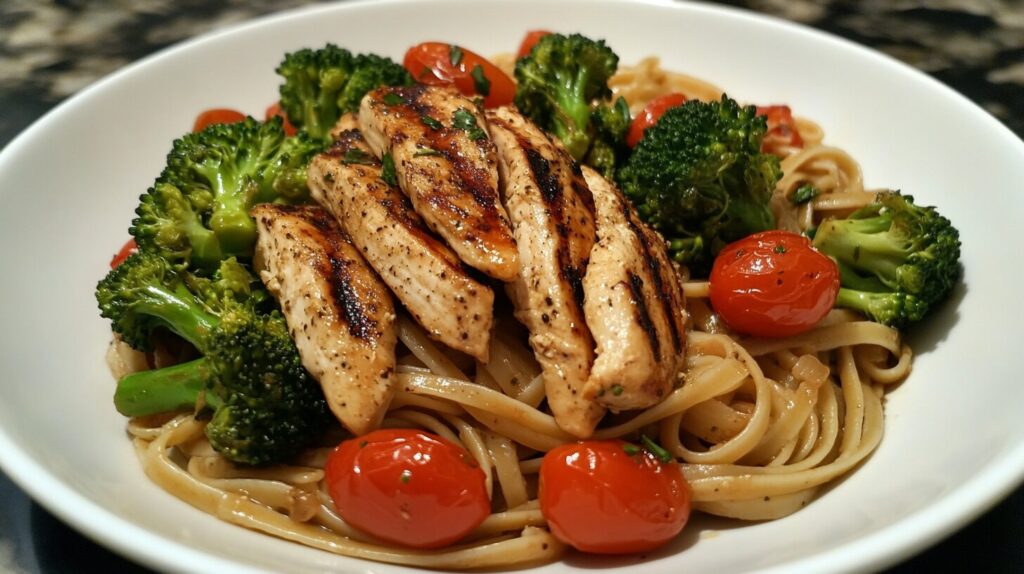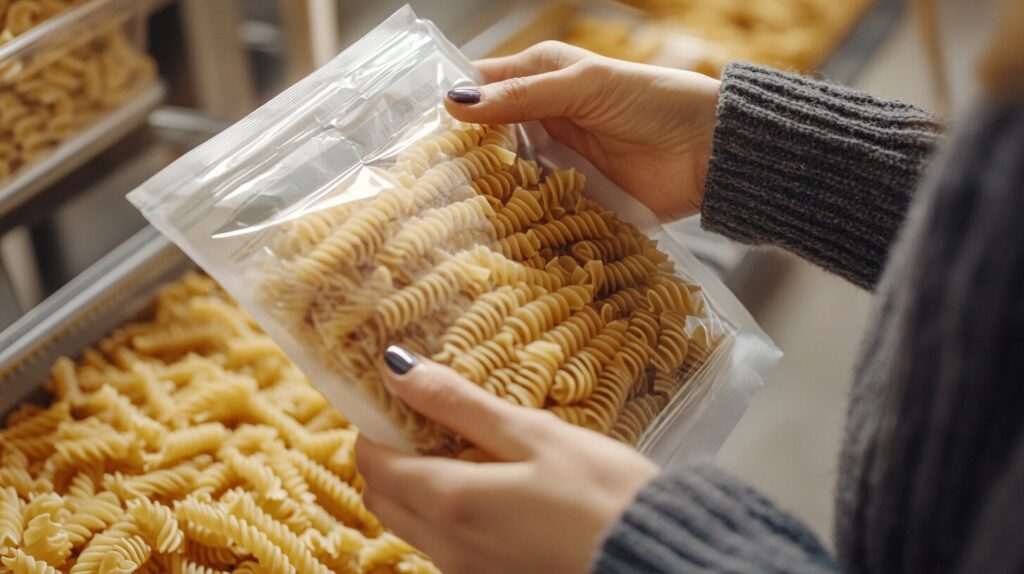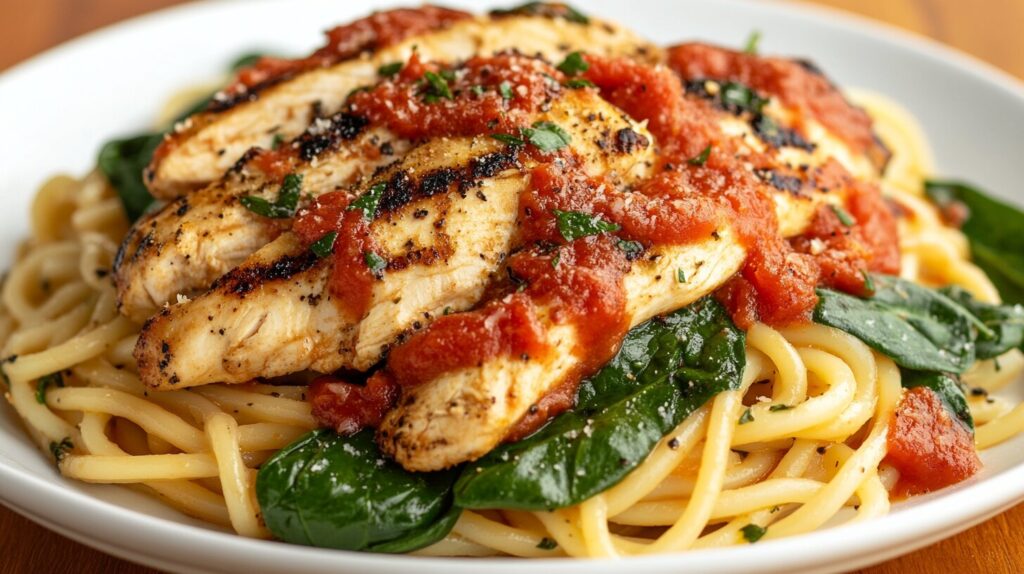
Polycystic Ovary Syndrome (PCOS) can feel like a never-ending puzzle, especially when it comes to diet. One of the biggest questions that pop up is about Pasta for PCOS. Can you still enjoy a bowl of spaghetti without triggering PCOS symptoms? Good news — the answer is yes! 🍝 You just need to know what types of Pasta for PCOS work best and how to enjoy them smartly. Let’s explore everything you need to know to keep pasta on your plate while managing PCOS effectively.
Table of Contents
Understanding PCOS and Carbohydrate Impact
The Link Between Insulin Resistance and PCOS
One of the core challenges of PCOS is insulin resistance. But what does that mean? In simple terms, your body has a harder time using insulin, which leads to higher blood sugar levels. Over time, this can cause weight gain, irregular periods, and other PCOS symptoms.
When you eat carbs — like those found in pasta — your body breaks them down into sugars. If these sugars are absorbed too quickly, they can spike your blood sugar, making insulin resistance worse. This is why understanding the right kind of Pasta for PCOS and how to eat it matters so much for managing PCOS.
Why Diet Matters for Managing PCOS Symptoms
Diet is one of the most powerful tools for managing PCOS. And while it might seem like pasta should be off-limits, that’s not entirely true. The key lies in:
- Choosing the right type of pasta.
- Balancing your meals with protein and fiber.
- Being mindful of portion sizes.
Eating smarter carbs can help stabilize blood sugar levels and reduce symptoms like fatigue, weight gain, and even acne. Think of your diet as the steering wheel for your PCOS — with the right choices, you can navigate symptoms more effectively.
“Food is not the enemy when you have PCOS. It’s your ally — you just need to know which foods are on your team.” 🍽️
Is Pasta Really Off-Limits for PCOS?
How Refined Carbs Affect PCOS
Regular pasta made from refined white flour can be problematic for PCOS. Why? Because it’s low in fiber and high in simple carbs. This means it gets digested quickly, leading to blood sugar spikes. These spikes can worsen insulin resistance and leave you feeling tired and hungry soon after eating.
Think of refined pasta like a matchstick: it burns hot and fast but doesn’t last long, which is why choosing the right Pasta for PCOS is important. This quick burst of energy is often followed by a slump, which isn’t great for anyone, especially those with PCOS.
Common Myths About Pasta and PCOS
There’s a lot of misinformation about pasta and PCOS out there. Let’s bust a few myths:
- Myth: You can’t eat pasta at all.
Truth: You can enjoy pasta — you just need to pick the right kind and pair it wisely. - Myth: All carbs are bad for PCOS.
Truth: Complex carbs like whole grains, legumes, and certain vegetables can be beneficial. - Myth: Gluten-free pasta is always healthier.
Truth: Some gluten-free pasta is just as high in refined carbs. Always check the label!
“PCOS doesn’t mean pasta is off the table — it just means you need to invite the right kind of pasta to dinner.” 🍝
Types of Pasta You Can Enjoy with PCOS

Thankfully, there’s a world of Pasta for PCOS options beyond the basic white spaghetti. Here are some excellent alternatives that won’t send your blood sugar soaring.
Whole Wheat Pasta: A Healthier Alternative
Whole wheat pasta is a simple swap for regular pasta, making it a great option for Pasta for PCOS. Unlike refined pasta, whole wheat pasta retains the bran and germ of the wheat, which boosts its fiber content. More fiber means slower digestion and a more gradual rise in blood sugar.
- Pros:
- Higher in fiber.
- Richer in nutrients like B vitamins and iron.
- Affordable and widely available.
- Cons:
- Slightly chewier texture, which not everyone loves.
A hearty bowl of whole wheat pasta with lean meat and veggies can be satisfying and PCOS-friendly.
Chickpea Pasta: High-Protein and Low-Glycemic Option
Chickpea pasta is a fantastic option for those with PCOS. Made from chickpea flour, it’s packed with protein and fiber, making it lower on the glycemic index (GI). This helps keep your blood sugar stable.
- Pros:
- High in protein and fiber.
- Naturally gluten-free.
- Creamy, nutty flavor.
- Cons:
- Can be pricier than regular pasta.
If you haven’t tried chickpea pasta yet, think of it as a creamy, nutty twist on your favorite noodles. It pairs wonderfully with garlic, olive oil, and veggies. 🥦
Lentil Pasta: A Nutrient-Dense Choice
Lentil pasta is another protein-packed option. Like chickpea pasta, it’s made from legume flour and offers a lower glycemic impact compared to white pasta.
- Pros:
- High in protein, iron, and fiber.
- Helps keep you full longer.
- Gluten-free and nutrient-dense.
- Cons:
- Can have a slightly earthy taste.
This pasta works beautifully with bold sauces like marinara or spicy arrabbiata. Think of it as the powerhouse athlete of the pasta world! 💪
How to Choose PCOS-Friendly Pasta

Checking the Glycemic Index (GI) of Pasta
The glycemic index (GI) measures how quickly a food raises your blood sugar. For PCOS management, you want pasta with a low to medium GI. Here’s a quick cheat sheet:
- Low GI Pasta: Chickpea pasta, lentil pasta, and quinoa pasta.
- Medium GI Pasta: Whole wheat pasta.
- High GI Pasta: White pasta, rice noodles, and instant pasta.
When in doubt, check the GI or opt for pasta with higher protein and fiber content.
The Importance of Fiber Content in Pasta
Fiber is your best friend when you have PCOS. Why? Because it slows down digestion and helps you feel full longer. When picking pasta, aim for at least 4-5 grams of fiber per serving.
Some great high-fiber pasta options include:
- Whole wheat pasta
- Chickpea pasta
- Lentil pasta
- Quinoa pasta
The more fiber, the slower your blood sugar will rise. Think of fiber as the brakes that keep your blood sugar from speeding out of control. 🚦
Portion Control: How Much Pasta is Okay with PCOS?
Recommended Serving Sizes for PCOS-Friendly Meals
When it comes to pasta and PCOS, portion control is key. Even the healthiest pasta can throw off your blood sugar if you eat too much of it. So, what’s the right amount?
A standard serving of pasta for someone with PCOS should be about ½ cup to 1 cup of cooked pasta. This might seem small if you’re used to heaping plates of spaghetti, but here’s the good news: when you balance it with protein and veggies, it becomes a satisfying meal.
Picture this: a bowl with a base of 1 cup of whole wheat pasta, topped with grilled chicken, sautéed spinach, and a sprinkle of Parmesan cheese. Yum, right? 🍽️
To make it easier, here’s a quick guide to pasta portions:
| Type of Pasta | Serving Size |
|---|---|
| Whole Wheat Pasta | 1 cup cooked |
| Chickpea or Lentil Pasta | 1 cup cooked |
| Quinoa Pasta | 1 cup cooked |
| Zoodles (Zucchini Noodles) | 1½ – 2 cups cooked |
Strategies to Avoid Overeating Pasta
It’s easy to overdo it with pasta — we’ve all been there! Here are some simple tricks to help you stick to the right portion size:
- Use smaller plates: It sounds silly, but smaller plates make your portions look larger, tricking your brain into feeling satisfied. 🍽️
- Bulk up with veggies: Add a ton of vegetables to your pasta dish. Bell peppers, broccoli, spinach, and mushrooms are all great options.
- Pair with protein: Add chicken, turkey, shrimp, or beans to your pasta. Protein helps keep you full and prevents overeating.
- Measure before cooking: Measure out your dry pasta before you boil it. About ½ cup of dry pasta typically yields 1 cup of cooked pasta.
Remember, pasta is just one part of your meal. Balance it with the right extras, and you won’t feel deprived.
“It’s not about giving up pasta; it’s about giving up the excess. Balance is your secret weapon!” ⚖️
Best Sauces and Toppings for PCOS-Friendly Pasta

Healthy Sauce Options: Tomato-Based, Pesto, and More
The sauce you choose can make or break your pasta dish, especially with PCOS. Avoid creamy, high-fat sauces like Alfredo, which are often loaded with calories and unhealthy fats. Instead, opt for these healthier options:
- Tomato-Based Sauces: Rich in antioxidants like lycopene, tomato sauces are a win. Just make sure they don’t have added sugars!
- Pesto: Made with basil, garlic, olive oil, and pine nuts, pesto is a flavorful option packed with healthy fats.
- Olive Oil and Garlic: Simple, light, and heart-healthy. Add some red pepper flakes for a kick. 🌶️
- Avocado Sauce: Creamy without the cream! Blend avocado with lemon juice, garlic, and herbs for a fresh sauce.
Quick Tip:
When buying store-bought sauces, read the label. Look for sauces with less than 5 grams of sugar per serving.
Toppings That Support PCOS Management
Toppings are like the cherry on top of your pasta masterpiece. Here are some PCOS-friendly toppings to enhance flavor and nutrition:
- Lean Proteins: Grilled chicken, shrimp, turkey meatballs, or tofu.
- Healthy Fats: Avocado slices, olives, or a sprinkle of nuts.
- Veggies: Spinach, bell peppers, cherry tomatoes, mushrooms, and zucchini.
- Herbs and Spices: Fresh basil, oregano, parsley, garlic, and red pepper flakes.
These toppings not only make your dish more delicious but also help stabilize blood sugar and keep you full longer. 🥑
“Think of toppings as the secret agents of your meal — they make everything better without stealing the spotlight.” 🎭
How to Cook Pasta for a Low Glycemic Impact
Cooking Methods that Reduce Pasta’s Glycemic Load
Did you know the way you cook your pasta can affect how it impacts your blood sugar? It’s true! Here are a few tips to lower the glycemic load of your pasta:
- Cook it al dente: This means cooking your pasta until it’s firm to the bite. Al dente pasta has a lower glycemic index than overcooked, mushy pasta because it takes longer to digest.
- Cool it down: After cooking, let your pasta cool slightly. This process creates something called resistant starch, which slows digestion and reduces the blood sugar spike. You can even enjoy pasta cold in a salad! 🥗
- Reheat strategically: Surprisingly, reheating cooled pasta can further lower its glycemic impact. Science for the win!
Combining Ingredients to Slow Carb Absorption
Pairing your pasta with the right ingredients can help slow down the absorption of carbs. Here’s how to build a balanced pasta dish that’s PCOS-friendly:
- Add Protein: Chicken, turkey, shrimp, beans, or tofu help slow down digestion.
- Include Healthy Fats: Olive oil, avocado, or nuts provide essential nutrients and stabilize blood sugar.
- Load Up on Fiber: Lots of veggies like spinach, broccoli, or zucchini add fiber and volume.
Example Meal Idea:
- Base: 1 cup of whole wheat pasta
- Protein: Grilled chicken breast
- Veggies: Sautéed spinach, mushrooms, and bell peppers
- Sauce: Pesto with a drizzle of olive oil
- Topping: Sprinkle of Parmesan cheese
This combo gives you a balanced meal that tastes amazing and keeps your blood sugar happy — the perfect approach to Pasta for PCOS.
Sample PCOS-Friendly Pasta Recipes
Whole Wheat Pasta with Grilled Chicken and Veggies
Ingredients:
- 1 cup whole wheat pasta
- 1 grilled chicken breast, sliced
- 1 cup broccoli florets
- ½ cup cherry tomatoes, halved
- 2 tablespoons olive oil
- 2 cloves garlic, minced
- Salt and pepper to taste
Instructions:
- Cook the pasta until al dente, then drain.
- Sauté garlic in olive oil, add broccoli, and cook until tender.
- Toss in cherry tomatoes and grilled chicken.
- Combine with pasta, season with salt and pepper, and enjoy!
Chickpea Pasta with Spinach and Garlic
Ingredients:
- 1 cup chickpea pasta
- 2 cups fresh spinach
- 2 cloves garlic, minced
- 1 tablespoon olive oil
- 1 tablespoon lemon juice
- Grated Parmesan cheese (optional)
Instructions:
- Cook chickpea pasta until al dente, then drain.
- Sauté garlic in olive oil, add spinach, and cook until wilted.
- Toss pasta with spinach and garlic, drizzle with lemon juice, and sprinkle with Parmesan.
H2: Mistakes to Avoid When Eating Pasta with PCOS
Ignoring Portion Sizes
One of the easiest mistakes to make with pasta — especially if you love it — is eating too much in one sitting. It’s easy to pile your plate high and call it a day. But with PCOS, portion control is crucial. Eating large amounts of pasta, even the healthier kinds, can still spike your blood sugar and worsen insulin resistance.
Stick to a 1-cup serving size of cooked pasta and balance it with lean protein and fiber-rich veggies. Remember, it’s not about depriving yourself but making smart choices. When you keep portions in check, you can enjoy pasta without guilt or negative effects.
Quick Tip: Use measuring cups until you get used to recognizing the correct portion size. It might feel tedious at first, but it becomes second nature with practice.
Choosing High-Sugar Sauces
Creamy Alfredo, store-bought marinara, or other pre-made sauces can be a sugar trap. Many processed pasta sauces contain added sugars and unhealthy fats, which can wreak havoc on your PCOS-friendly diet.
Always check the nutrition label and look for sauces with less than 5 grams of sugar per serving. Even better, make your own sauces at home where you can control the ingredients. A simple blend of tomatoes, garlic, herbs, and olive oil can create a delicious and healthy sauce.
Healthy Sauce Ideas:
- Homemade marinara with no added sugar. 🍅
- Pesto made with fresh basil, garlic, pine nuts, and olive oil. 🌿
- Simple olive oil and garlic for a light, classic flavor.
Forgetting to Add Protein and Fiber
Eating pasta alone, no matter how healthy, won’t give you the balanced meal your body needs. With PCOS, the goal is to slow down the digestion of carbs to avoid blood sugar spikes. The best way to do this is by adding protein and fiber.
Think of protein and fiber as the anchors that keep your blood sugar steady. Without them, even whole wheat or legume-based pasta can lead to quick digestion and energy crashes.
Perfect PCOS-Friendly Meal Formula:
- Base: 1 cup of pasta (whole wheat, chickpea, lentil, etc.)
- Protein: Chicken, turkey, shrimp, tofu, or beans.
- Veggies: Broccoli, spinach, bell peppers, zucchini, mushrooms.
- Healthy Fat: Olive oil, avocado, nuts, or seeds.
By combining these elements, you create a meal that’s satisfying, nutritious, and PCOS-friendly.
“A balanced pasta dish is like a well-orchestrated symphony — every ingredient plays a role to create harmony.” 🎵
FAQs: Common Questions About Eating Pasta with PCOS
Can I Eat Gluten-Free Pasta with PCOS?
Yes, you can eat gluten-free pasta if you have PCOS. However, not all gluten-free pastas are created equal. Some gluten-free options are made from rice flour or corn flour, which can be high in simple carbs and low in fiber. These can spike your blood sugar just like regular white pasta.
Instead, choose high-protein, high-fiber gluten-free options like:
- Chickpea pasta
- Lentil pasta
- Quinoa pasta
Always check the label to see the fiber and protein content before making a decision.
How Often Can I Eat Pasta if I Have PCOS?
Moderation is key. You don’t need to cut pasta out of your life completely. You can enjoy pasta 1-2 times per week if you’re mindful of portion sizes and pair it with protein and veggies.
Listen to your body and observe how you feel after eating pasta. If you feel sluggish or notice symptoms flaring up, you might want to reduce the frequency or switch to lower-carb pasta alternatives like zoodles.
Is There a Difference Between Fresh and Dried Pasta?
Yes, there can be a difference. Fresh pasta tends to have a higher glycemic index than dried pasta because it absorbs water differently during cooking. This means fresh pasta can spike your blood sugar faster.
Dried pasta — especially whole wheat or legume-based dried pasta — is usually the better option for PCOS. It has a lower glycemic impact and a higher fiber content.
Can I Eat Pasta Salads with PCOS?
Absolutely! Pasta salads can be a fantastic PCOS-friendly meal, especially if you use the right pasta and ingredients. Here are a few tips:
- Use whole wheat, chickpea, or lentil pasta as the base.
- Add lots of raw veggies like cherry tomatoes, cucumbers, bell peppers, and spinach.
- Include a lean protein like grilled chicken, chickpeas, or tofu.
- Dress with a simple vinaigrette made from olive oil and lemon juice instead of creamy dressings.
What’s the Best Low-Carb Pasta Alternative for PCOS?
If you’re looking for a low-carb option, try:
- Zoodles (zucchini noodles)
- Spaghetti squash
- Shirataki noodles (made from konjac root)
These alternatives are naturally low in carbs and calories, making them perfect for managing PCOS. Plus, they can be just as satisfying when paired with the right sauce and toppings.
Explore More PCOS-Friendly Recipes and Tips 🍽️
If you’re looking for more ways to balance your diet with PCOS, we’ve got you covered! Check out these helpful articles:
- Delicious and Nutritious PCOS Recipes for a Healthy Lifestyle – Get inspired with meal ideas that support your well-being.
- What Is a Good Meal Plan for PCOS? – Discover actionable tips for planning your weekly meals.
- Rice Cakes: Benefits and Recipes for Healthy Snacking – Learn how to incorporate healthy, satisfying snacks into your diet.
These resources will help you stay on track while keeping your meals exciting and satisfying!
Conclusion: Enjoying Pasta Mindfully with PCOS
Living with PCOS doesn’t mean giving up all your favorite foods — and that includes pasta! The key is making smart choices, focusing on portion control, and balancing your meals with protein and fiber. By choosing healthier pasta alternatives like whole wheat, chickpea, lentil, or quinoa pasta, you can satisfy your pasta cravings without worsening your symptoms.
Remember, it’s not about perfection; it’s about progress and finding what works best for your body. 🍝
“With the right knowledge and a little creativity, pasta can remain a comforting and nourishing part of your PCOS-friendly lifestyle.” 💪
